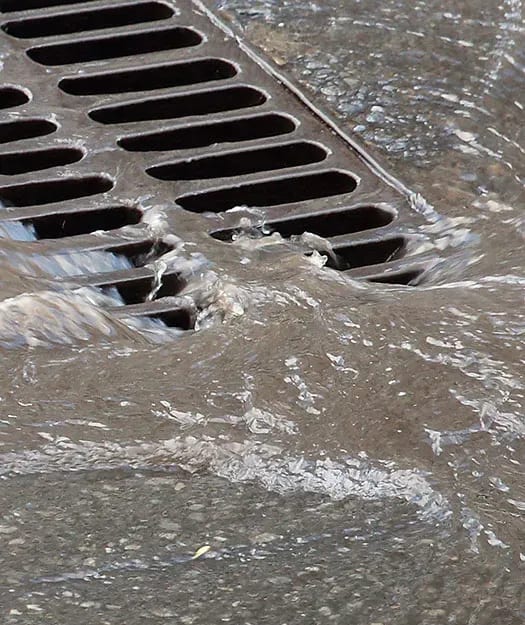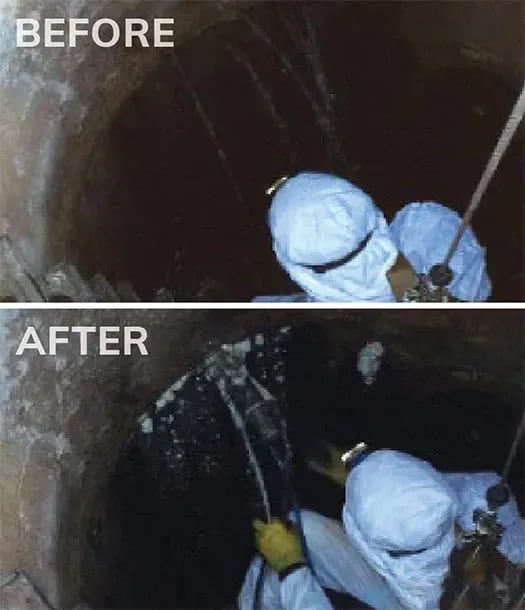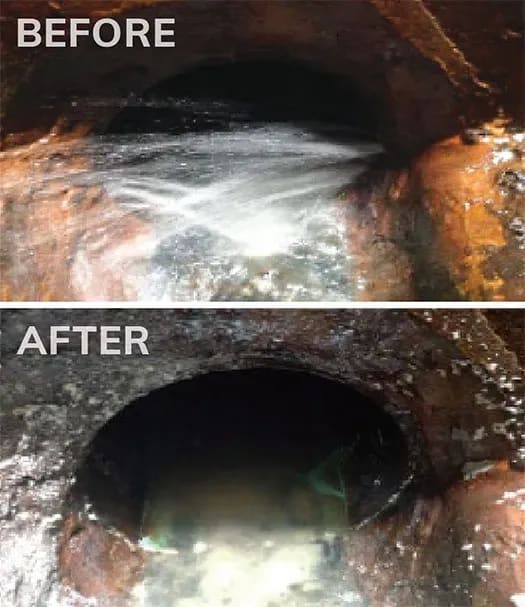Manhole Inflow and Infiltration Sealing in Indiana
Problem
During a time of increasing commercial development in Clarksville, Indiana, the city of Clarksville noticed unusually high levels of water at its Pump Station 10 (PS10) which caused a strain on its wastewater treatment plant (WWTP). During high rain events, some pump stations experienced a 500% increase in flow and the WWTP experienced a 300% increase. Due to budgetary constraints, the city put off repairs as long as possible, but was forced to address the issue when it threatened their ability to sign future capacity letters for new commercial developments.
Analysis
To determine the cause of the problem, flow monitoring was conducted starting at PS10. The monitoring tracked the issues back to a gravity outlet at Pump Station 33 (PS33). CCTV sewer inspection determined that the pipe was in good condition, but that the joints and manholes were leaking due to inflow and infiltration (I&I). The PS33 manholes were in a swampy area next to I-65 that became highly saturated from highway and commercial drainage. Clarksville evaluated lining, moving the line, and Cured in Place Pipe (CIPP) as repair options, but ultimately chose URETEK’s Deep Injection® (UDI) polymer application because it was more cost-effective, avoided certain access issues, and came with a two-year warranty.
Solution
Seven manholes needed to be rehabilitated, but only four required complete encapsulations. For the three manholes with general I&I issues, UDI polymer injections would take place at the point on leakage and expand throughout voids, sealing the structures against further I&I. In the four manholes that required encapsulation, UDI injections would be performed radially to ensure full coverage and polyurethane sealing.
Result
In just 1.5 days, all seven manholes were repaired, the area was restored to full operation, and positive results were seen. The high-pressure leaks stopped immediately and a decrease in flow at both PS33 and PS10 was observed. The city analyzed the flow rates before and after the repair and found a reduction of 26.91 pumping hours per week which equated to 2.34 million gallons of water per week and an annual savings of $1.1 million. Additionally, the repairs mitigated the need for a new pump station, saving the city $750,000. Rehabilitating their city infrastructure set up Clarksville for future economic and population growth, and URETEK saved the city a great deal of time, money, and headache in the process.
URETEK Deep Injection® (UDI)
Widely referenced throughout our industry, UDI involves the injection of structural polymer into base and subgrade soils to increase the load bearing capacity. This is achieved by injecting the polymer through small holes drilled directly through the pavement structure to depths determined by site-specific analysis. Our URETEK 486 Star® material flows easily into voids and weak zones within the soil mass below. Through a controlled chemical reaction, the expanding polymer compacts surrounding soils and applies a controlled pressure on targeted areas of the affected pavement above. If needed, a multi-injection design plan is utilized to gently return the pavement to its original grade. The composite material quickly cures into a strong, dimensionally stable, and water-resistant geo-material, providing years of reliable service.
URETEK 486 Star®
URETEK 486 Star® polymer is a two-component, high-density, expanding thermoset polyurethane system. It was developed to be the ideal solution for under-sealing, void filling, lifting of settled pavement, stabilization and stiffening of weak soils, and for encapsulating and sealing buried infrastructure. URETEK 486 Star® is environmentally inert, non-toxic, and resists underground water erosion or weakening due to its industry-leading hydrophobic properties.


